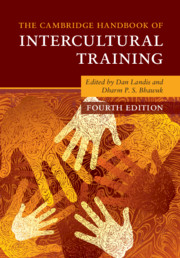Book contents
- The Cambridge Handbook of Intercultural Training
- Reviews
- The Cambridge Handbook of Intercultural Training
- Copyright page
- Dedication
- Frontispiece
- Contents
- Figures
- Tables
- Editors and Contributors
- Foreword
- Preface
- 1 Introduction and Theoretical Framework
- Part I Theoretical Foundations of Intercultural Training
- 2 Harry Triandis’s Contributions to Intercultural Training as a Field of Research
- 3 Interdisciplinary History of Intercultural Communication Studies
- 4 Culture Theories and Intercultural Training
- 5 An Analysis of Methods for Intercultural Training
- 6 Intercultural Simulations
- 7 Toward a Social Network Theory of Reentry
- 8 Intractable Conflict, Delegitimization, and Intercultural Training
- 9 Evaluation of Cross-Cultural Training
- Part II Practice of Intercultural Training
- Part III Indigenous Psychology and Intercultural Training
- Part IV New Interdisciplinary Approaches to Intercultural Training
- Part V Summing Up
- Index
- References
6 - Intercultural Simulations
Theory and Practice
from Part I - Theoretical Foundations of Intercultural Training
Published online by Cambridge University Press: 18 September 2020
- The Cambridge Handbook of Intercultural Training
- Reviews
- The Cambridge Handbook of Intercultural Training
- Copyright page
- Dedication
- Frontispiece
- Contents
- Figures
- Tables
- Editors and Contributors
- Foreword
- Preface
- 1 Introduction and Theoretical Framework
- Part I Theoretical Foundations of Intercultural Training
- 2 Harry Triandis’s Contributions to Intercultural Training as a Field of Research
- 3 Interdisciplinary History of Intercultural Communication Studies
- 4 Culture Theories and Intercultural Training
- 5 An Analysis of Methods for Intercultural Training
- 6 Intercultural Simulations
- 7 Toward a Social Network Theory of Reentry
- 8 Intractable Conflict, Delegitimization, and Intercultural Training
- 9 Evaluation of Cross-Cultural Training
- Part II Practice of Intercultural Training
- Part III Indigenous Psychology and Intercultural Training
- Part IV New Interdisciplinary Approaches to Intercultural Training
- Part V Summing Up
- Index
- References
Summary
This chapter briefly surveys the field of intercultural sensitivity training programs and focuses on intercultural simulations as a method to replicate real intercultural interactions and allow participants to experience important aspects of intercultural interactions and to consider their experience in the light of the cultural and cross-cultural context of the interactions. These replications reveal the underlying dynamics and sources of perceptual and interpretative bias that may confound intercultural interaction, such as the fundamental attribution error, ethnocentric, and homogeneity biases that may produce confusion, misattribution, and even conflict. The chapter identifies numerous typologies and situates simulations in an experiential category. The chapter describes two experiential methods in some detail and provides suggestions for extracting insights made available to participants by elevating the saliency of culture to the interpretation of the interactions. Strengths and potential limitations are identified.
- Type
- Chapter
- Information
- The Cambridge Handbook of Intercultural Training , pp. 258 - 280Publisher: Cambridge University PressPrint publication year: 2020
References
- 2
- Cited by



